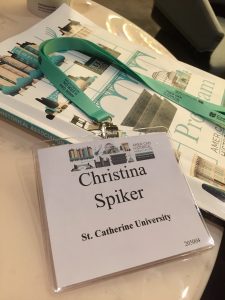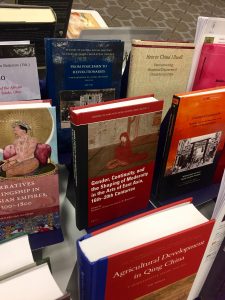
It is the day before the last day of the American Historical Association conference 2018. I’ve got my chai in hand, my presentation finished, and my swag from the exhibition hall in tow. All in all a great time. It has been a great conference for making new connections and reconnecting with some old friends from UCI in History and Asian Studies.
The panel that I presented on, #s98 Optics: Race, Religion, and Technology in East Asian Photography, 1868-1949, had a great synergy:
Christina M Spiker, “Reproducing Alterity: Photography, Illustration, and the Maintenance of Ainu Stereotypes in Meiji and Taisho Japan”
Paul D. Barclay, “Picture Postcards of Imperial Japan’s Peoples and Places”
Matthew Combs, “Reframing China: Kodak and the Growth of Amateur Photography, 1920-45”
Joseph W. Ho, “Framing Chaos: Contingency, Community, and American Missionary Visual Practices in Wartime China”
There were surprising connections between Paul’s work and my own, Joe and Matt shared a “Kodak Connection,” and Joe’s presentation made me really reconsider the role of Reverend John Batchelor in Ainu representation. Plus Joe let us play with old cameras that he reconstructed. An extremely cool opportunity for any photography and material culture buff! I would love to get my hands on some for the classroom.

I had the opportunity to attend and tweet some interesting panels: #s29 Digital Projects Lightning Round, #s142 Resistant and Receptive, Insiders and Outsiders: Native Peoples and the Making of Early Modern Indigenous Sovereignty, Colonial Subjects, and Slaves, #s214 Displaying the Nation: Visions of Past and Future in Modern Japan. Tomorrow morning I will see my friend Yidi Wu’s presentation on #s264 Grassroots Activism in 20th-Century Asia: Lessons from Russia, China, and North Vietnam and if I have time I will head to #s310 Empire, Race, and Sovereignty in Hawai’i From Kingdom to Statehood. There has been very little downtime!
In the exhibition hall, I also had the rare opportunity to spot a book that I contributed to in the Brill booth. This was a first for me and I am immensely proud of the work that everyone put in!
Some issues that I’ve been thinking a lot about as we wrap things up:
- The conference has allowed me to clearly see the value and contributions of my own discipline. I value the many contributions by history — my work is not possible without them. But there is a true art to visual analysis that can bring a presentation alive. Images are sources in an of themselves and paying attention to their stories can open us up to new lines of inquiry. I’ve seen a lot of interesting archival material this trip — from maps to advertisements to video — and I keep thinking that asking “what” the images show is only part of the equation. We need to ask “how” they mean what they do. To quote W. J. T. Mitchell’s essay that my students grappled with all semester, “What do Pictures Really Want?” So in sum, conference has been a valuable opportunity for defining myself as a scholar outside of my own field.
- The most interesting papers to listen to are those that still have questions to ask. I’ve seen a wide range of papers this trip — from presentations based on recently published work to real works in progress. And as a listener, I enjoy thinking through some of the problems alongside the speaker. The audience has so much to contribute, but there needs to be space to do so. I’m not a perfectionist by any means, but it encourages me to leave some areas open to debate so that I can benefit from the insight and observations of those around me.
- And finally, a question. How can recognize the violence of the archive? This was a question asked by a few of the papers that I heard (such as the lightening paper by Anelise Shrout and a paper about Tupi language(s) in Eastern South America by M. Kittiya Lee). The types of information (and the organizations collecting it) often contribute to forms of historical erasure. I need to meditate more deeply on this issue within my own work.
Looking forward to enjoying tomorrow and then seeing some family before returning home to St. Paul to prepare for Spring Semester.